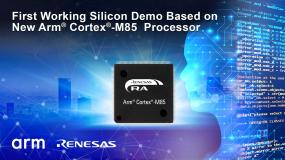Renesas Electronics Corporation, a provider of advanced semiconductor solutions, announced that it will present the first live demonstration of a microcontroller (MCU) based on the recently announced Arm Cortex-M85 processor. The demonstration will take place at the Renesas booth – Hall 1, Stand 234 (1-234) at the Embedded World 2022 Exhibition and Conference in Nuremberg, Germany, June 21-24.
 Renesas introduced the RA (Renesas Advanced) family of Arm Cortex-M-based MCUs in October 2019, entering the general-purpose Arm-Cortex-M market with a robust and feature-rich family of flash-based MCUs. In about 30 months, Renesas quickly assumed a leadership position, introducing 17 MCU groups encompassing well over 200 individual parts.
Renesas introduced the RA (Renesas Advanced) family of Arm Cortex-M-based MCUs in October 2019, entering the general-purpose Arm-Cortex-M market with a robust and feature-rich family of flash-based MCUs. In about 30 months, Renesas quickly assumed a leadership position, introducing 17 MCU groups encompassing well over 200 individual parts.
Additionally, Renesas has developed a robust partner ecosystem that provides customers with comprehensive solutions for IoT, AI/ML, industrial automation, medical, building automation, home appliances and various other applications.
“As a premier partner of Arm, we are proud to be the first to demonstrate an MCU based on the high-performance Cortex-M85 processor, a clear example of the momentum we have built in the Arm ecosystem,” said Roger Wendelken, senior vice president of the Arm business unit. Renesas' IoT and infrastructure business. “The RA family has achieved tremendous success in a very short time, demonstrating the key strengths that make Renesas an MCU powerhouse, including design expertise, legendary quality and close collaboration with customers and partners in all markets and all geographies.”
The Arm Cortex-M85 processor features Helium technology, Arm's M-Profile vector extension that enables advanced DSP/ML capabilities and helps accelerate compute-intensive applications such as endpoint AI. Offering more than 6 CoreMark/MHz, the Cortex-M85 enables demanding IoT use cases that require the highest compute performance and DSP or ML capability, realized on a single, simple-to-program Cortex-M processor. Cortex-M features such as deterministic operation, short interrupt response time, and state-of-the-art support for low power consumption are not compromised in the Cortex-M85.
Renesas is developing a new series of RA MCUs based on the Cortex-M85 processor, planned for launch in 2023. These new RA family MCUs will provide breakthrough performance and fully deterministic, low-latency, real-time operation for demanding application needs in several markets. . New AR devices will bridge the gap between MCUs and MPUs, enabling complex, compute-intensive applications with the lower power consumption and ease of use of an MCU.
This will help customers preserve their software development investment and reduce migration costs to an MPU-based system. As with other RA MCUs, the new devices will offer best-in-class peripherals, memory and low power consumption.
“To continue to scale and grow, the next generation of IoT solutions requires ever-improving levels of performance, security and simplified development, and we deliver this with the new Arm Cortex-M85,” said Dipti Vachani, senior vice president and general manager , Automotive and IoT business line at Arm. “This demonstration of the first silicon based on our most secure and highest performance Cortex-M processor will showcase the exciting new applications it will enable and further consolidate our ongoing close collaboration with Renesas.”
The new Cortex-M85 core based on the Armv8-M architecture supports Arm TrustZone technology for secure asset protection. Combined with TrustZone, Renesas' integrated cryptographic engine, immutable storage, key management and tamper protection against DPA/SPA side-channel attacks will provide comprehensive and fully integrated secure element functionality.
The Armv8-M architecture also brings Pointer Authentication/Branch Target Identification (PAC/BTI) security extension, a new architectural feature that provides enhanced mitigation of software attack threats and helps achieve PSA Level 2 certification.
The new AR MCUs based on the Cortex-M85 core will be supported by Renesas' Flexible Software Package (FSP). FSP enables faster application development by providing all the necessary infrastructure software, including multiple RTOS, BSP, peripheral drivers, middleware, connectivity, networking and security stacks, as well as reference software to build complex AI, control and control solutions. engine and graphics. It allows customers to integrate their own legacy code and choice of RTOS with FSP, providing complete flexibility in application development. Using FSP will make it easier to migrate existing projects to new AR devices.

